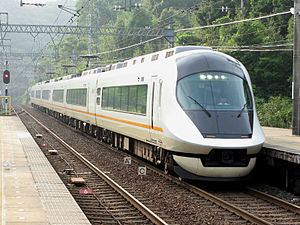Line length 78.8 km (49.0 mi) | Operating speed | |
 | ||
Type Heavy railCommuter rail Track gauge 1,435 mm (4 ft 8 ⁄2 in) Old gauge 1,067 mm (3 ft 6 in)(until 1959) Electrification 1,500 V DCOverhead lines Locale | ||
The Nagoya Line (名古屋線, Nagoya-sen) is a railway line owned and operated by the Kintetsu Railway, a Japanese private railway company, connecting Nagoya and Ise Nakagawa Station in Matsusaka, Mie Prefecture via Kuwana, Yokkaichi, Suzuka, Tsu municipalities along the Ise Bay. The official origin of the line is Ise-Nakagawa and the end is Nagoya, however, operationally trains "down" from and "up" to Nagoya.
Contents
The line approximately parallels the Central Japan Railway Company (JR Central) Kansai Main Line, the Ise Railway, and the JR Central Kisei Main Line, all three offering rapid service from Nagoya to Ise.
At Ise-Nakagawa, the line has connections to the Osaka Line to Uehommachi and Kintetsu Namba Stations of downtown Osaka, and to the Yamada Line to Ujiyamada Station and beyond Toba Station on the Toba Line and Kashikojima Station of the Shima Line, to provide touristic access to scenic Shima Peninsula and Ise Shrine.
Services
LO Local (普通 futsū)
For Shiratsuka, Yokkaichi, Nagoya For Tomiyoshi, Yokkaichi, Shiratsuka, Ise-Nakagawa(Locals stop at every station.)
SE Semi-Express (準急 junkyū)
EX Express (急行 kyūkō)
LE Limited Express (特急 tokkyū)
NS Non-stop Limited Express (ノンストップ特急 nonsutoppu tokkyū)
SV Premium Express Shimakaze (しまかぜ Shimakaze)
For Nagoya For Kashikojima(Trains for Kashikojima run once a day except on Wednesday with some exceptions.)(Seat reservations, limited express fee and special vehicle fee required.)History
The first section, between Shiroko and Takadahonzan, was opened in 1915 by an independent railway operator Ise Electric Railway (伊勢電気鉄道, Ise Denki Testudō) with rail gauge 1,067 mm (3 ft 6 in). The line was extended to Tsu-shinmachi and Kusu in 1917, and to (now) Kintetsu-Yokkaichi in 1922, the line being electrified at 1500 VDC in 1926. It was extended as an electrified line to Kuwana in 1929, and to Ise-Nakagawa the following year.
In 1936 the line was acquired by the Sangu Express Railway Co., which duplicated the Kuwana - Kusu section in 1938, the year that the Kansai Express Railway Co. opened the Nagoya - Kuwana section as electrified dual track.
In 1940 the Sangū Kyūkō Electric Railway (参宮急行電鉄, Sangū Kyukō Dentetsu) merged with the Kansai Express Railway Co., a predecessor of Kintetsu.
The Kusu - Hisai section was duplicated between 1937 and 1955, and the dual tracking of the line was completed in 1972 with duplication of the Hisai - Ise-Nakagawa section.
Gauge conversion
After the acquisition of a 1435mm connection to Osaka, Kintetsu passengers to that destination needed to change trains due to the difference of gauges. In 1959 the disastrous Ise-wan Typhoon destroyed the line and Kintetsu decided to convert to 1,435 mm (4 ft 8 1⁄2 in) gauge (standard gauge) with the reconstruction, the standard of the company to enable direct operation between Osaka and Nagoya. Today a number of Limited Express trains between Osaka and Nagoya, and between Nagoya and Ise and Shima area are operated.
